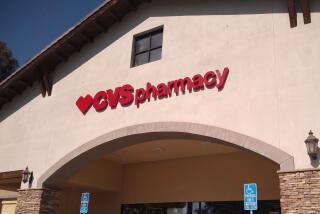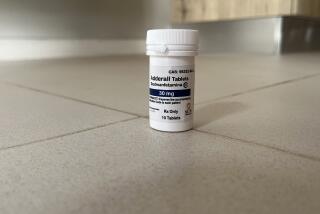Tranquilizers Continue to Lose Appeal
- Share via
Americans’ longstanding love affair with tranquilizers continues to wane, according to a new government report on prescription drug use. At the same time, the report indicated, powerful antibiotics developed in the last two decades are being used too often and too much by doctors when less powerful weapons might fight infection just as effectively.
Tranquilizers like Valium accounted for only 2.9% of the drug costs of inpatients and outpatients combined, according to a newly published survey of 1982 drug prescribing patterns by the U.S. Food and Drug Administration.
New Report The new government report found drugs to control irregular heart rhythms and blood pressure, as well as the powerful new antibiotics, responsible for the greatest proportion of the $3 billion spent by hospitals and $14.5 billion by consumers on prescription drugs of all kinds.
Publicity about the real and potential dangers of excess use of tranquilizers toppled Valium from top position on the FDA’s list of the 25 most heavily prescribed drugs about three years ago, and government analysts now say the public has apparently adopted more reasonable expectations for such preparations.
Experts in and out of government say greatly increased public awareness about the dangers of tranquilizers--dating to the mid-1970s--is largely responsible for breaking prescribing patterns influenced heavily by drug company promotion and advertising to doctors.
Experts in pharmacology who reviewed the new FDA listing, however, noted that the positioning of drugs may be as much a commentary on the increasing complexity of medical economics as anything else. They warned of the dangers of trying to assess trends in medicine in the comparative vacuum of drug prescribing patterns alone, but the new FDA analysis seeks to establish the context in which drugs are ordered by doctors as clearly as possible.
The list, prepared annually for the last four years, ranks the often prescribed drugs. This year, for the first time, the report analyzes trends in the amount of money spent for drugs by consumers and hospitals. The greatest sum went to the ulcer drug Tagamet and the most prescriptions were issued for Dyazide, a diuretic widely used in the treatment of high blood pressure.
The new FDA report appeared last week in the Journal of the American Medical Assn.
In all, the government figures indicate, the volume of prescriptions and the amount of money Americans are spending on such drugs reflects about the same increase as the population in general and hikes in the Consumer Price Index. The tabulation does not include over-the-counter remedies, like aspirin, or any illicit drugs.
Commonly Abused Of the 25 substances on the government’s listing of those on which the most money was spent, two--Valium and Tranxene (No. 23)--are commonly abused tranquilizers and one, Tylenol with codeine (No. 17), has been widely linked with diversion to the illicit market. A form of Darvon, a painkiller that also has been widely abused, held to the 15th spot in the ratings.
The list of the top 25 drugs in terms of dollar sales focused on specific brand-name preparations. But the government also released rankings of the most heavily sold broad classes of drugs. Mind-altering drugs lagged in third place, responsible for 7.3% of all sales, behind antibiotics of all kinds (13.6%) and drugs for the wide range of heart problems (12.5%).
Among frequently used specific drug types, substances to control irregular heartbeats captured 5.2% of the total drug market; a class of powerful new antibiotics called cephalosporins took 4.9%; a large class of hypertension/heart drugs called beta-blockers accounted for 3.4%, as did oral contraceptives, while minor tranquilizers in general, including Valium and at least a dozen similar preparations, took 2.9%.
The FDA analysis was based on actual sales by a sample group of 1,200 selected drugstores and a similar survey of hospitals. The measures were correlated with such data as the Consumer Price Index, Census reports and reports by doctors of what drugs they prescribed. The blend of figures led the FDA to estimate that 1.5 billion prescriptions were filled by retail pharmacies in 1982--a 5% increase over the previous year. New prescriptions accounted for 51% of the total and refills for the rest.
Increased 12% Both the total of prescriptions and the population of the United States have increased about 12% since 1971, the FDA concluded, but prescribing patterns have been far more erratic. After the number of prescriptions jumped by 38% from 1971 to 1977, it declined from 1977 to 1979, then started to increase again. But prescriptions were essentially unchanged in number in 1981 and 1982.
FDA experts said the new figures--the 1982 report represents the most recent year for which statistics have been completely analyzed--apparently reinforce a growing impression in medicine that widespread tranquilizer abuse has at least begun to decline. But Carlene Baum, who headed the FDA team, noted that the new analysis of dollar volume of drug sales makes clear that the cephalosporin drug group is enjoying extremely rapid growth, both in dollar volume and total number of prescriptions.
Analysts outside government raised questions, however, about the growing expenditures on cephalosporins, suggesting that the FDA figures both ignore some hidden drug costs and reflect what many doctors worry may be overuse of the highly effective antibiotics. What may be involved, these doctors fear, is excess prescribing fomented by heavy promotion and advertising by drug makers who find the cephalosporin market increasingly competitive and crowded with manufacturers eager to enhance their market share.
Used Two Decades Ago Cephalosporins first were used two decades ago, but today’s versions are the third major generation produced by researchers and have generally been on the market only about five years. Reserved almost entirely for in-hospital administration and seldom prescribed for outpatient use, cephalosporins have proven able to cure tough, exotic infections that developed by natural evolution and germs that built immunities to earlier types of antibiotics, including the familiar penicillin and ampicillin.
Because today’s antibiotics are being outstripped and rendered ineffective by newly developed infections far more quickly than the generations of anti-infectives that preceded them, said Dr. Peter Heseltine, an associate professor at the USC Medical School, drug makers find themselves forced into heavy promotion to recoup research costs within only six or seven years after a new substance is introduced.
The families of powerful new antibiotics represent the farthest forward combat front line in the constant fight against infections. But what critics are saying, in essence, is that these front-line weapons are being used to fight every skirmish against disease--not just the comparatively small number for which they are appropriate. At the same time, said Heseltine, more and more drug makers are being attracted to the lucrative cephalosporin trade, a situation that has led to cut-throat competition and over-promotion.
Heseltine said that cephalosporins--though their effectiveness and usefulness as antibiotics in many of the worst hospital infection cases is unquestioned--are being overused by physicians who prescribe them when less potent, cheaper drugs would still work just as well. “I don’t think there’s any doubt about that,” said Heseltine. “Very often, a newly advertised and more expensive drug is no better than one that’s been available for some time.”
Analysts Surprised The FDA’s Baum conceded the government analysts had been surprised by the heavy volume of high-priced antibiotics they found prescribed in 1982. Baum noted that the new report is the first prepared by the FDA in which cost figures from the Bureau of Labor Statistics have been included in the analysis. She said that, overall, prescription drugs accounted for only about 8% of the Consumer Price Index, a total she said that did not seem inordinately large.
But the volume of powerful antibiotics in use puzzled the researchers, Baum said, cautioning that the team did not believe it had adequate data to draw conclusions about why the heavy use is occurring. “I don’t think we saw anything in our data that indicates any impropriety,” she said.
There is another problem, too, that makes assigning the true costs related to cephalosporins and some other drug types difficult to estimate, agreed Heseltine and Dr. Robert Maronde, professor of medicine and head of the clinical pharmacy section at USC. The new report, both doctors agreed, ranks drugs by money spent on them without regard to the costs of delivering them to a patient in the hospital. Some newer antibiotics, both men agreed, are effective when they are given just once or twice a day, while some older preparations must be given four or five times a day. Total costs for the newer drugs are actually less, said Maronde, because the sometimes substantial price attached to administering one dose of a drug to an inpatient is cut by half or more.
But the measures available to the FDA analysts are not sensitive enough to take into account such comparative cost differences, Maronde and Heseltine said. The problem, experts agreed, underscores why it is so difficult to effectively control--or even dissect--the growing cost of health care.
“When you use a new medication, there should be only three considerations,” Heseltine said. “Is my patient going to get better quicker? Second, is there any less toxicity to the new drug? Third, is there a cost advantage to using this new drug, if the first two answers are that both drugs are about the same?
“Yet this is, unfortunately, (not always) what goes through the minds of (some) physicians when they prescribe. They tend to get left behind.”
America’s Top Selling Pills The U.S. Food and Drug Administration list of the top 25 brand name prescription drugs measured in terms of dollar sales, 1982. Manufacturers are listed with each product. 1. Tagamet (ulcer treatment), Smith Kline & French 2. Inderal (blood pressure and heart treatment), Ayerst 3. Valium (tranquilizer), Roche 4. Dyazide (diuretic), Smith Kline & French 5. Motrin (antiinflammatory), Upjohn 6. Keflex (antibiotic), Dista 7. Aldomet (blood presure), Merck Sharp & Dohme 8. Naprosyn (antiinflammatory), Syntex 9. Clinoril (antiinflammatory), Merck Sharp & Dohme 10. Lasix (diuretic), Hoechst-Roussel 11. Diabinese (diabetes treatment), Pfizer 12. Lopressor (blood pressure), Geigy 13. Indocin (antiinflammatory), Merck, Sharp & Dohme 14. Feldene (antiinflammatory), Pfizer 15. Darvocet-N (painkiller), Lilly 16. Aldoril (blood pressure), Merck Sharp & Dohme 17. Tylenol with codeine (painkiller), McNeil 18. Procardia (angina treatment), Pfizer 19. Isordil (angina), Ives 20. Persantine (angina), Boehringer Ingelheim 21. Timoptic (glaucoma drug), Merck Sharp & Dohme 22. Minipress (blood pressure), Pfizer 23. Tranxene (tranquilizer), Abbott 24. Hygroton (blood pressure), USV 25. Lo/Ovral 21 (birth control pill), Wyeth Source: National Prescription Audit.
More to Read
Sign up for Essential California
The most important California stories and recommendations in your inbox every morning.
You may occasionally receive promotional content from the Los Angeles Times.










